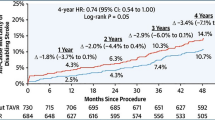Abstract
Reperfusion therapy for acute myocardial infarction is one of the most thoroughly studied treatments in all of medicine. The GISSI-1 and ISIS-2 megatrials definitively established the superiority of intravenous streptokinase over conservative care for this condition. Tissue plasminogen activator (t-PA) was introduced with the expectation that it would be substantially more effective than streptokinase. It was also priced at approximately $2000 more than streptokinase, a cost differential that set the stage for a heated and often contentious debate about the added value of t-PA. Two European trials, GISSI-2 and ISIS-3, subsequently found that t-PA and streptokinase provided equivalent health outcomes. It was in this setting that the GUSTO trial was conceived. The major result of GUSTO was the finding that accelerated t-PA saved 11 additional lives per 1000 patients treated. In order to address the question of whether the extra benefits of t-PA were worth its significant extra costs, we performed a detailed cost-effectiveness analysis using the empirical data from the GUSTO-I trial. The net incremental cost for each patient shifted from streptokinase to t-PA in GUSTO-I was $2845. the majority of this difference was attributable to the difference in the cost of the thrombolytic agents. Survival modeling showed that accelerated t-PA added 0.14 undiscounted years per patient or, alternatively, that each of the 11 extra survivors per 1000 patients shifted from streptokinase to t-PA lived an average of 14 additional years. The incremental cost-effectiveness ratio for routine substitution of t-PA for streptokinase was $32,678 per added life year. Compared with standard benchmarks, our analysis shows that routine substitution of t-PA for streptokinase is “economically attractive.” Subgroups analysis further showed that cost-effectiveness ratios were most favorable in older patients and in anterior myocardial infarctions. Perhaps one of the most important results of the GUSTO-I trial is that it demonstrates that an expensive new biotechnology therapy can have a favorable economic profile if it produces sufficient additional health benefits.
Access this article
We’re sorry, something doesn't seem to be working properly.
Please try refreshing the page. If that doesn't work, please contact support so we can address the problem.
Similar content being viewed by others
References
Fibrinolytic Therapy Trialists' (FTT) Collaborative Group. Indications for fibrinolytic therapy in suspected acute myocardial infarction: Collaborative overview of early mortality and major morbidity results from all randomised trials of more than 1000 patients. Lancet 1994;343:311–322.
DeWood MA, Spores J, Notske R, et al. Prevalence of total coronary occlusion during the early hours of transmural myocardial infarction. N Engl J Med 1980;303:897–902.
Reimer KA, Lowe JE, Rasmussen MM, Jennings RB. The wave-front phenomenon of ischemic cell death: Myocardial infarct size versus duration of coronary occlusion in dogs. Circulation 1977;56:786–794.
Rentrop KP, Feit F, Blanke H, et al. Effects of intracoronary streptokinase and intracoronary nitroglycerin infusion on coronary angiographic patterns and mortality in patients with acute myocardial infarction. N Engl J Med 1984;311: 1457–1463.
Kennedy JW, Ritchie JL, Davis KB, et al. Western Wash ington randomized trial of intracoronary streptokinase in acute myocardial infarction. N Engl J Med 1983;309: 1477–1482.
Simoons ML, Vos J, Tijssen JPG, et al. Long-term benefit of early thrombolytic therapy in patients with acute myocardial infarction: 5 year follow-up of a trial conducted by the Intel-university Cardiology Institute of the Netherlands. J Am Coll Cardiol 1989;14:1609–1615.
Gruppo Italiano per Lo Studio Della Streptochinasi, Nell'Infarcto Miocardico (GISSI). Effectiveness of intravenous thrombolytic treatment in acute myocardial infarction. Lancet 1986;1:349–360.
ISIS-2 (Second International Study of Infarct Survival): Randomised trial of intravenous streptokinase, oral aspirin, both, or neither among 17,187 cases of suspected acute myocardial infarction: ISIS-2. Lancet 1988;2:349–360.
Califf RM, Topol EJ. The paradigm of acute reperfusion and the GUSTO I trial. In: Califf RM, Mark DB, Wagner GS, eds. Acute Coronary Care. St. Louis, Mo: Mosby-Year Book, 1995, pp. 69–83.
The TIMI Study Group. The thrombosis in myocardial infarction trial: Phase I findings. N Engl J Med 1985;312:932.
Wilcox RG, von der Lippe G, Olsson CG, Jensen G, Skene AM, Hampton JR, ASSET Study Group. Trial of tissue plasminogen activator for mortality reduction in acute myocardial infarction. Anglo-Scandinavian Study of Early Thrombolysis (ASSET). Lancet 1988;2:526–530.
Gruppo Italiano per Lo Studio Della Sopravvivenza, Nell'Infarcto Miocardico: GISSI-2: A factorial randomised trial of alteplase versus streptokinase and heparin versus no heparin among 12,490 patients with acute myocardial infarction. Lancet 1990;336:65–71.
ISIS-3 Collaborative Group. ISIS-3: A randomised comparison of streptokinase vs. tissue plasminogen activator vs. anistreplase and of aspirin plus heparin vs. aspirin alone among 41,299 cases of suspected acute myocardial infarction. Lancet 1992;339:753–770.
The GUSTO Investigators. An international randomized trial comparing four thrombolytic strategies for acute myocardial infarction. N Engl J Med 1993;329–673–682.
The GUSTO Angiographic Investigators. The effects of tissue plasminogen activator, streptokinase, or both on coronary-artery patency, ventricular function, and survival after acute myocardial infarction. N Engl J Med 1993;329: 1615–1622.
Mark DB, Hlatky MA, Califf RM, et al. Cost effectiveness of thrombolytic therapy with tissue plasminogen activator as compared with streptokinase for acute myocardial infarction. N Engl J Med 1995;332:1418–1424.
Detsky AS, Naglie IG. A clinician's guide to cost-effectiveness analysis. Ann Inter Med 1990:113:147–154.
Weinstein MC, Pineberg HV, Elstein AS, et al. Clinical Decision Analysis. Philadelphia: WB Saunders, 1980.
Mark DB. Medical economics and health policy issues for interventional cardiology. In: Topol EJ, (ed). Textbook of Interventional Cardiology. Philadelphia: WB Saunders, 1993, pp. 1323–1353.
Anonymous. 1994 Drug Topics Red Book. Montvale, NJ: Medical Economics Data, 1994.
Naylor CD, Bronskill S, Goel V. Cost-effectiveness of intravenous thrombolytic drugs for acute myocardial infarction. Can J Cardiol 1993;9:553–558.
Author information
Authors and Affiliations
Rights and permissions
About this article
Cite this article
Mark, D.B. Economics and quality of life after acute myocardial infarction: Insights from GUSTO-I. J Thromb Thrombol 3, 151–155 (1996). https://doi.org/10.1007/BF00132408
Issue Date:
DOI: https://doi.org/10.1007/BF00132408




